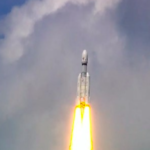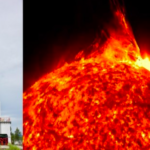Nuclear and space are two strategic sectors in which India and the US agreed to work together recently.
While the two countries will work on the development of next generation small modular reactor technologies for domestic and export markets, in the space field, the US will fly Indian astronauts to the International Space Station (ISS) next year.
The proposed spaceflight mission is in addition to the NISAR satellite built by the two countries and to be launched by India next year.
In the nuclear power field, small modular reactors are the new development. Small modular reactors are the ones which are factory-made compact with less than 300 MW capacity.
Nuclear power equipment manufacturers like Russia’s Rosatom, French company EDF and the US based NuScale Energy are now looking at the small modular reactor segment.
For global nuclear power plant makers, small is now beautiful and they are looking at populating their small modular reactors across the world.
With lesser gestation time, higher power generation period and lower risks, nuclear power plant manufacturers are now of the view that small is beautiful and are in favour of small modular reactors, experts had earlier told IANS.
Incidentally, the world’s first land-based small modular reactor (SMR) with RITM-200N is slated to be commissioned in 2028 in the Russian Arctic region, said Director General of Rosatom Alexey Likhachev.
Prime Minister Narendra Modi and US President Joe Biden have underscored the important role nuclear energy plays in global decarbonization efforts and affirmed nuclear energy as a necessary resource to meet nations’ climate, energy transition, and energy security needs.
While India will house six Rosatom, Russia’s nuclear reactors, in Tamil Nadu — two are already generating power and four are under construction — the US company Westinghouse Electric Company (WEC) is negotiating with Nuclear Power Corporation of India Ltd (NPCIL) to set up six atomic power stations in India.
The US Department of Energy and India’s Department of Atomic Energy are having intense consultations for facilitating the opportunities for WEC to develop a techno-commercial offer for the Kovvada nuclear project in India.
The US also reaffirmed its support for India’s membership in the Nuclear Suppliers Group and commits to continue engagement with like minded partners to advance this goal.
That apart, the two democratic countries have bilateral cooperation on cutting-edge scientific infrastructure, including a $140 million in-kind contribution from India’s Department of Atomic Energy to the US Department of Energy’s Fermi National Laboratory toward collaborative development of the Proton Improvement Plan-II Accelerator, for the Long Baseline Neutrino Facility — the first and largest international research facility on American soil.
The Laser Interferometer Gravitational-Wave Observatory (LIGO) being built in Maharashtra is also an Indo-US initiative in the field of astronomy.
Forty years after Russia carried an Indian to space in its spacecraft, the US will be doing that but to the International Space Station.
The space agencies of two countries – Indian Space Research Organisation (ISRO) and National Aeronautics and Space Administration (NASA) will develop a strategic framework for human spaceflight cooperation by the end of 2023.
NASA will provide advanced training to Indian astronauts at the Johnson Space Center in Houston, Texas, with a goal of mounting a joint effort to the International Space Station in 2024.
It may be recalled that it was Wing Commander Rakesh Sharma who had travelled to space in a Russian rocket in 1984.
Be that as it may, the other Indo-US joint space programme NASA-ISRO Synthetic Aperture Radar (NISAR) — an earth observation satellite — will be orbited by an Indian rocket next year from the Sriharikota rocket port in Andhra Pradesh.
The NISAR is an earth observation satellite jointly built by NASA and ISRO. The satellite has already reached India from the US.
Modi and Biden called for enhanced commercial collaboration between the US and Indian private sectors in the entire value chain of the space economy and to address export controls and facilitate technology transfer.
India also signed the Artemis Accords — it was the 27th nation to do so — which advance a common vision of space exploration.
(With the inputs of Agency).


